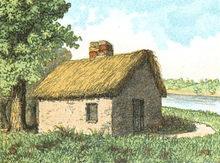William Blaxton
Reverend William Blaxton (also spelled William Blackstone) (1595– 26 May 1675)[1] was an early English settler in New England and the first European settler of Boston and Rhode Island.

Biography
William Blaxton was born in Horncastle, Lincolnshire,[2] England, the son of a minister. He was admitted to Emmanuel College, Cambridge as a sizar in 1614 and received an MA in 1621.[3] He was ordained as a priest of the Church of England in May 1619 by Thomas Dove, Bishop of Peterborough.[4]
Blaxton joined the failed Ferdinando Gorges expedition to America in 1623, and he arrived in Weymouth, Massachusetts in 1623 on the ship Katherine[5] as a chaplain in the subsequent expedition of Robert Gorges. Most of his fellow travelers returned to England in 1625, and he became the first colonist to settle in Boston, living alone there. The Puritans landed in nearby Charlestown in 1629 but they had problems finding potable water, so Blaxton invited them to settle on his land in Boston in 1630. They then granted him 50 acres (200,000 m2), but he sold it back to them in 1634, and this land now makes up Boston Common, a central public park in downtown Boston.

Blaxton purportedly did not get along with the leaders of the Boston church, so he moved about 35 miles (56 km) south of Boston to what the Indians called the Pawtucket River, today known as the Blackstone River in Cumberland, Rhode Island. He was the first settler in Rhode Island in 1635, one year before Roger Williams established Providence Plantations. The area that Blaxton settled was part of the Plymouth Colony until 1691, when it came under the jurisdiction of Massachusetts Bay Colony until 1741; it finally became part of the Colony of Rhode Island and Providence Plantations. He tended cattle, planted gardens, and cultivated an apple orchard, and he cultivated the first variety of American apples, the Yellow Sweeting. He called his home "Study Hill" and was said to have the largest library in the colonies at the time, but his library and house were burned during King Philip's War around 1675.
Blaxton's friends included Narragansetts Miantonomi and Canonchet, and Wampanoags Massasoit and Metacomet.[6] Metacomet is notoriously known today as King Philip, whose followers burned Blaxton's home to the ground.
Roger Williams and Blaxton disagreed on many theological matters, but they remained lifelong friends. Williams frequently invited him to preach in Providence, and he also preached at other churches throughout Rhode Island. According to one modern journalist, he "is considered to be the pioneer clergyman of the Protestant Episcopal Church in the United States."[7] He married widow Sarah Fisher Stevenson in Boston on 4 July 1659 at the age of 64,[8] and they had a son named John (1660–1743). Sarah died in June 1673[9] at the age of 48, and Blaxton died in 1675 at the age of 80, leaving substantial holdings in real estate.[10]
Legacy
Namesakes
- Blackstone, Massachusetts
- Blackstone River
- Blackstone River Valley National Heritage Corridor
- Blackstone Canal
- Blackstone Street in Boston
- Blackstone Boulevard, Providence
- Blackstone River and Canal Heritage State Park in Uxbridge, Massachusetts
Memorials
- William Blackstone Memorial Park in Cumberland, Rhode Island[11]
- Plaque on Beacon Street in Boston marking the site of his house
- Plaque on Boston Common commemorating the sale of his land
Notable descendants
- Harriet Blackstone (1864 – 1939), painter
- Timothy Blackstone (1829 – 1900), industrialist
- William Eugene Blackstone (1841 – 1935), evangelist and Zionist; author of the proto-Zionist Blackstone Memorial of 1891
References
- 1944-, Anderson, Robert Charles. The great migration begins: immigrants to New England, 1620-1633. New England Historic Genealogical Society. Boston. ISBN 088082042X. OCLC 33083117.CS1 maint: numeric names: authors list (link)
- http://commons.wikimedia.org/wiki/File:Reverend_William_Blaxton_plaque,_Boston,_MA_-_DSC00183.JPG
- "William Blaxton (BLKN614W)". A Cambridge Alumni Database. University of Cambridge.
- Ordination Record: Blaxton, William in "CCEd, the Clergy of the Church of England database" (Accessed online, 9 January 2018)
- Banks, Charles Edward (1937). Topographical dictionary of 2885 English emigrants to New England, 1620–1650. The Bertram press. p. 96.
- Amory, Thomas C. (Thomas Coffin) (1877). William Blackstone, Boston's first inhabitant. The Library of Congress. Boston : Rockwell & Churchill, printers.
- "Who is William Blackstone?". Retrieved 2008-06-13.
- Ancestry.com. Massachusetts, Town and Vital Records, 1620–1988 [database on-line]. Provo, UT, USA: Ancestry.com Operations, Inc., 2011. Original data: Town and City Clerks of Massachusetts. Massachusetts Vital and Town Records. Provo, UT: Holbrook Research Institute (Jay and Delene Holbrook).
- The Genealogical Dictionary of Rhode Island: Comprising Three Generations of Settlers who Came Before 1690, with Many Families Carried to the Fourth Generation - John Osborne Austin, George Andrews Moriarty -Genealogical Publishing Com, 1887 - Reference - 496 pages (Page 21)
- Find A Grave
- Lind, Louise. "William Blackstone Memorial Park". Quahog.
Further reading
- Thomas Coffin Amory. William Blackstone, Boston's First Inhabitant, 2nd ed. Boston: Rockwell & Churchill, 1877. Google books
- B.F. DeCosta. William Blackstone in His Relation to Massachusetts and Rhode Island. NY: Mallory, 1880. Google books
- "New England in the Earliest Days", A. L. Rowse, American Heritage, May 22, 1959
- The story of William Blackstone, with local color, from the Worcester Telegram & Gazette
- Louise Lind. "William Blackstone, Sage of the Wilderness", Blackstone Valley Tourism Council.
- "The Independent Man" Newsletter of the Rhode Island Society of the Sons of the American Revolution. March 2012 (Number 3) – Mr Blackstone's River by Albert Klyberg.
- The Blackstone family : being sketches, biographical and genealogical, of William Blackstone, and his descendants by Sargent, Lucius M. (Lucius Manlius), 1786-1867
External links
- Early Settlers (from bucklinsociety.net)
- Weymouth - The First Hundred Years, Ted Clarke, Weymouth Historical Commission
- Who is William Blackstone? - short, readable biography of a very interesting pioneer